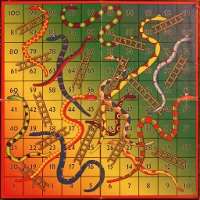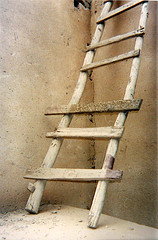Snakes and ladders: end-game rules

My 5-year-old son is mysteriously keen on a Snakes And Ladders game we have, but there is often some discussion about what the ending rule should be. The winner is definitely the person who lands on square 100 first, but what to do if you roll a number which would take you past square 100? There are two rules we play:
- You win.
- You bounce back off the end of the board. E.g., from square 98, a roll of 6 would take you: 99, 100, 99, 98, 97, 96.

Photo © Nick Fedele. CC-BY-SA-2.0
Empirically, the game takes way longer if you play the ‘bounce’ rule than if you play the ‘win’ rule. But how much longer, on average?
It turns out that a ‘bounce’ game takes over twice as long as a ‘win’ game. This post explains how I arrived at this conclusion.
Computer simulation
It’s fairly straightforward to use a pseudo-random number generator to simulate the game, including the effects of the 13 snakes and 13 ladders on our board. On my machine, I can simulate about eight million one-player games per second like this.
One-player results

Photo © sbluerock. CC-BY-SA-2.0
On average, it takes a single player the following numbers of rolls to reach square 100 and win:
| 59·1 | rolls under the ‘win’ rule; |
| 134·8 | rolls under the ‘bounce’ rule. |
For a single player, then, it takes more than twice as long to play a game under the ‘bounce’ rule as under the ‘win’ rule.
Two-player results
For a two-player game, we expect an average game to take less than twice the number of rolls a one-player game takes, because the game stops as soon as either player wins, and it will be common for one player to be luckier than average. This is indeed what happens in the simulations:
| 68·9 | rolls under the ‘win’ rule; |
| 145·8 | rolls under the ‘bounce’ rule. |
It turns out to be a good bit less than twice the number of rolls as the one-player game. The conclusion is about the same, though, which is that the ‘bounce’ rule makes the games last over twice as long as the ‘win’ rule.
Other observations
- The shortest possible one-player game takes six rolls, consisting of: 3 (to square 3, then up ladder to 20); 2 (to 22, up ladder to 37); 1 (to 38, up ladder to 59); 2 (to 61, up ladder to 78); 3 (to 81, up ladder to 98); 2 (to 100, win). You only have a 0·06% chance of this happening, though.
- In a two-player game, the first player to roll enjoys a slight edge, winning 50·5% of the time under ‘win’, and 50·2% of the time under ‘bounce’.
- The distribution is very skewed. Some very long games are possible: 2% of one-player games take more than 200 rolls. This explains the small increase in average when moving from a one-player to a two-player game.
- What happens if you play the rule that you get another go whenever you roll a 6? I haven’t explored this.
The huge ladder
There is a massive ladder from 17 up to 74. If he misses this, Zach often expresses the hope that he’ll soon land on a snake to get another go at the ladder. The two snakes which will give you another chance at this ladder are 26–10 and 39–5. We could formulate the question as: if you start at squares 10 or 27, how many rolls does it take to win? Similarly for squares 5 or 40. For a single player using the ‘win’ end-rule, we can simulate this, and get, for the 26–10 snake:
| Starting from square | 10 | it takes | 56·55 | rolls to win |
| 27 | 56·72 | |||
| 28 | 56·48 | |||
| 29 | 56·22 |
You’re better off hitting the 26–10 snake’s head than just getting past it (and landing on square 27), but you’re better off still to get at least two squares beyond.
For the 39–5 snake:
| Starting from square | 5 | it takes | 57·86 | rolls to win |
| 40 | 53·70 |
so you’re better off not hitting this snake at all.
More mathematical approach
This question has been studied before. The situation is well captured by a Markov model, which this paper uses (on a different board) to get some interesting results:
- How long is a game of snakes and ladders? S.C. Althoen, L. King, K. Schilling, The Mathematical Gazette v.77 n.478 pp.71–76, March 1993.